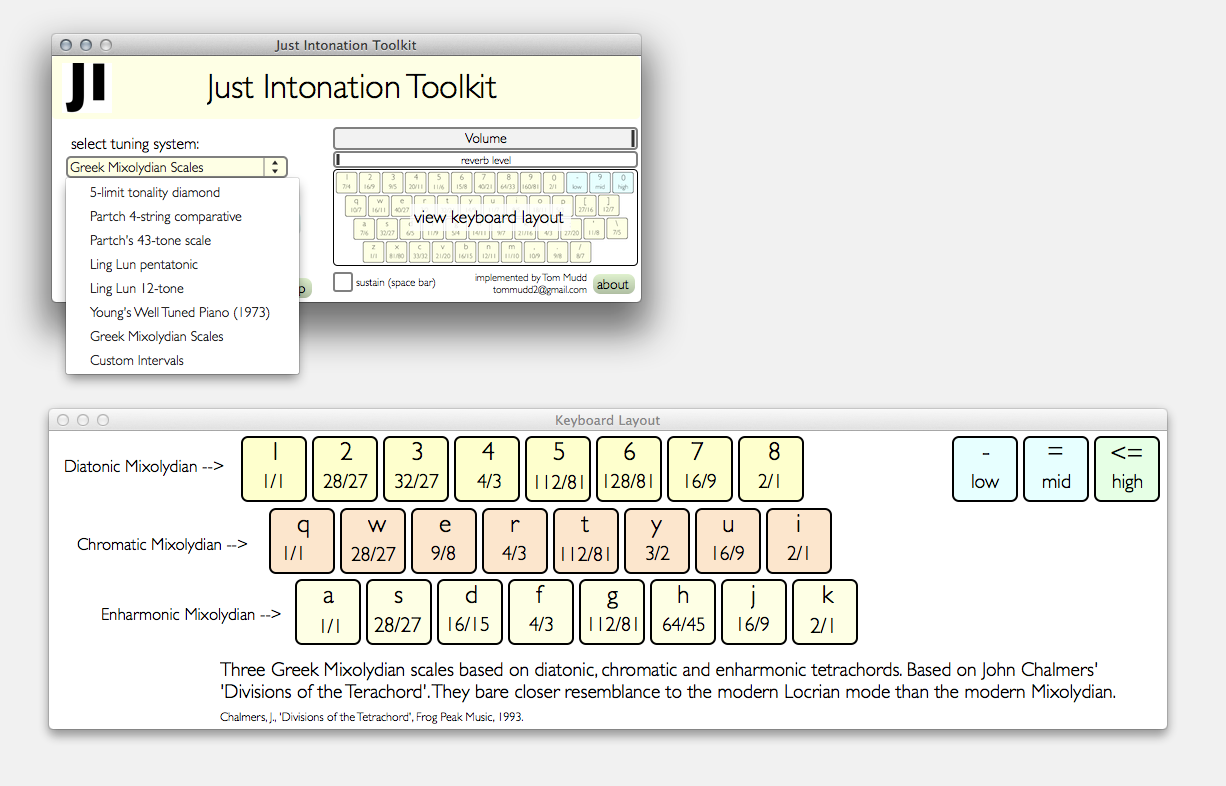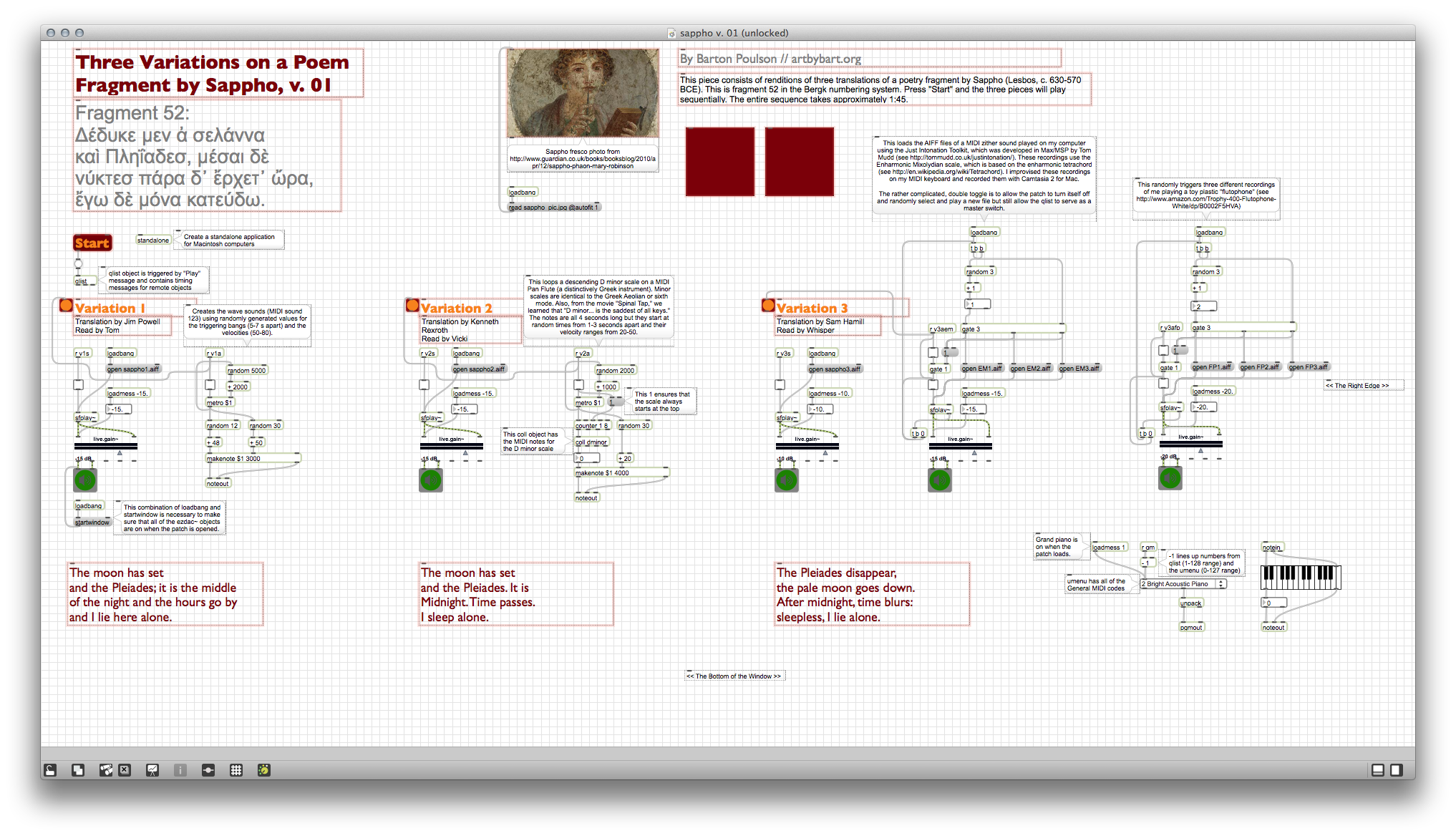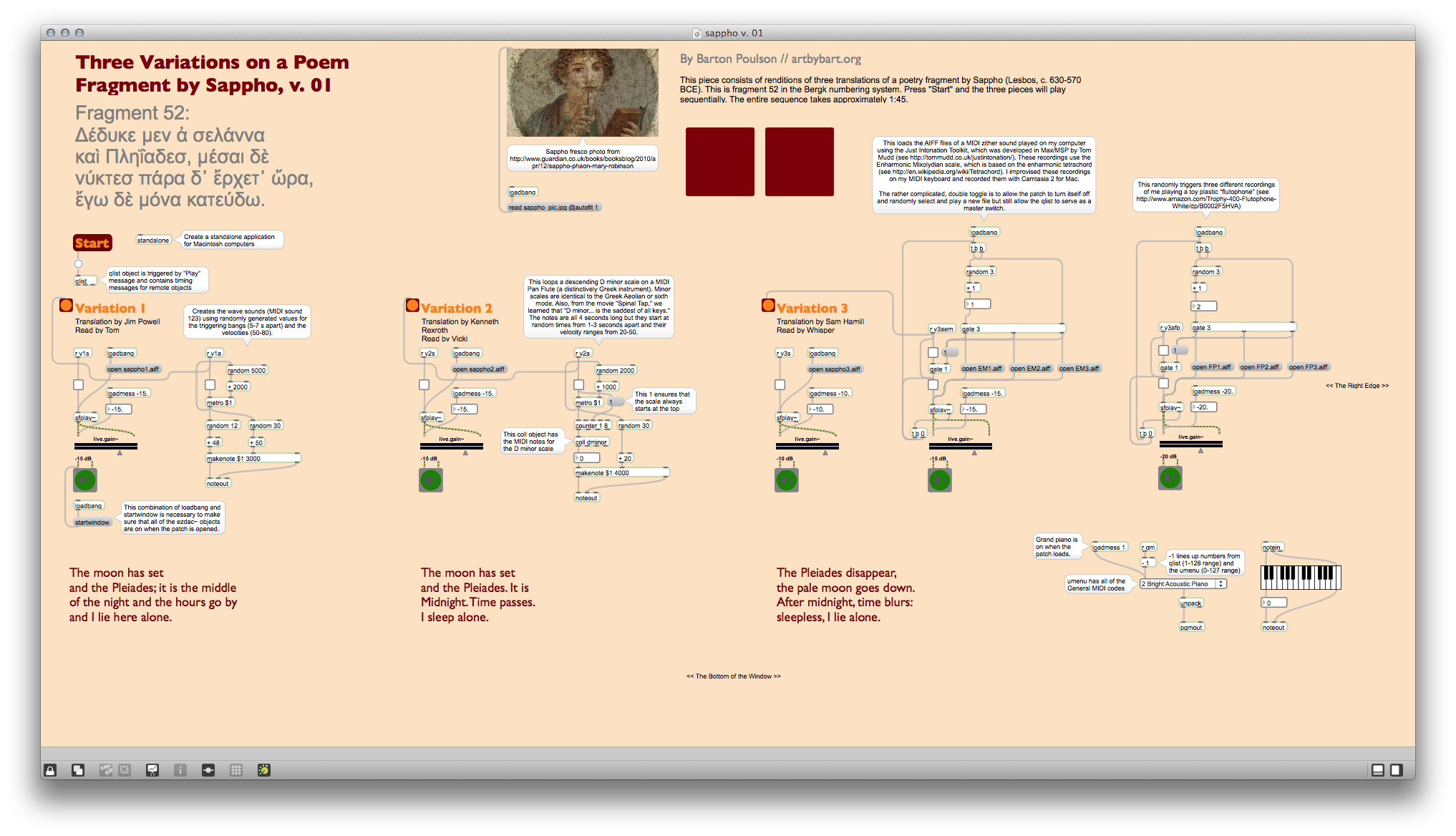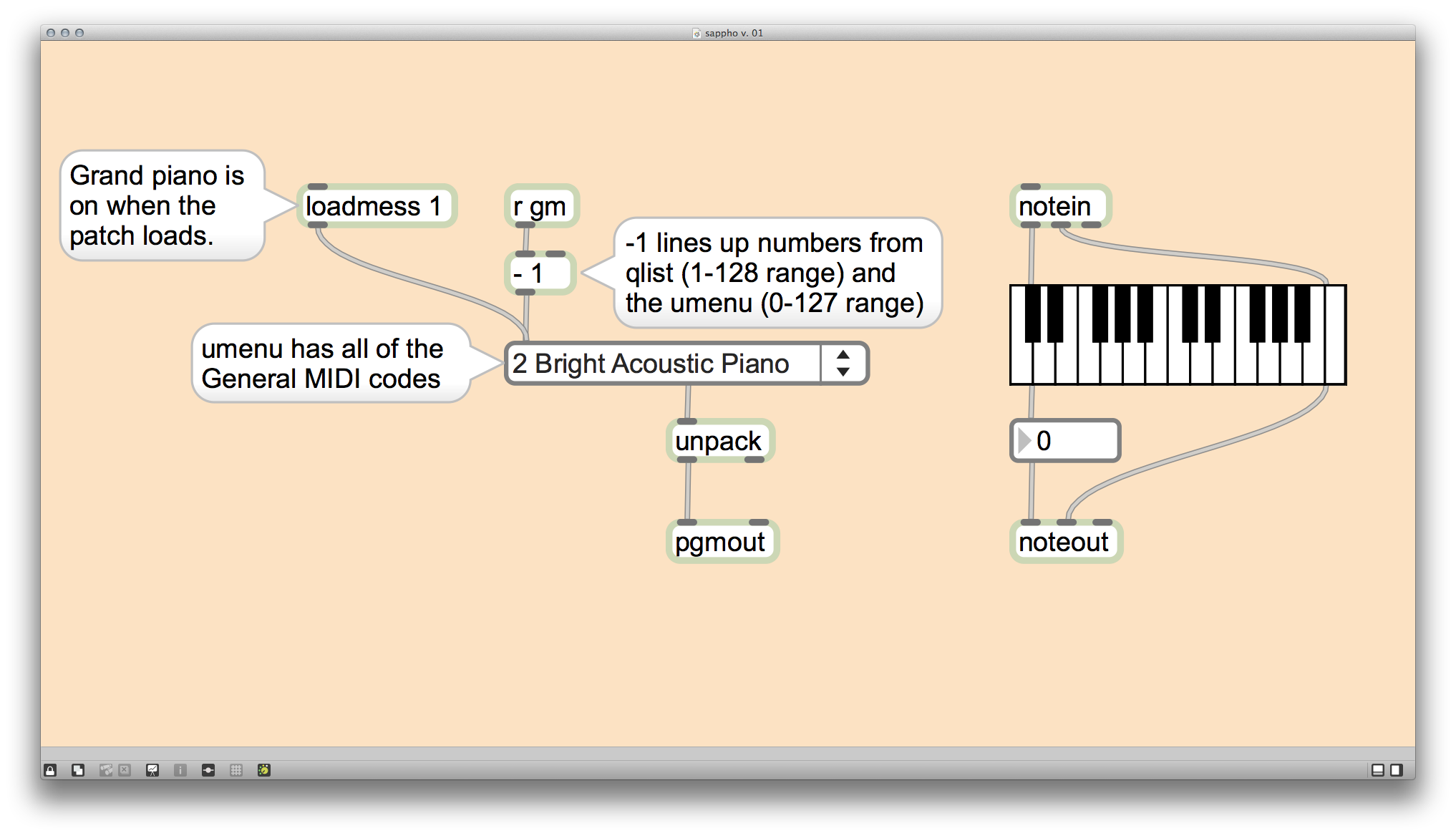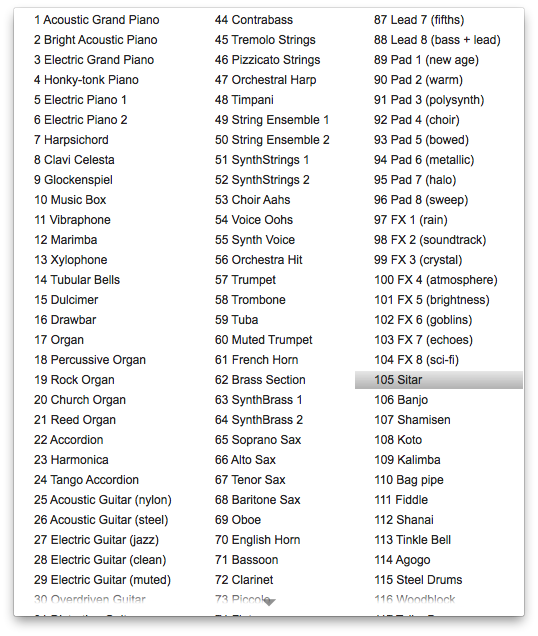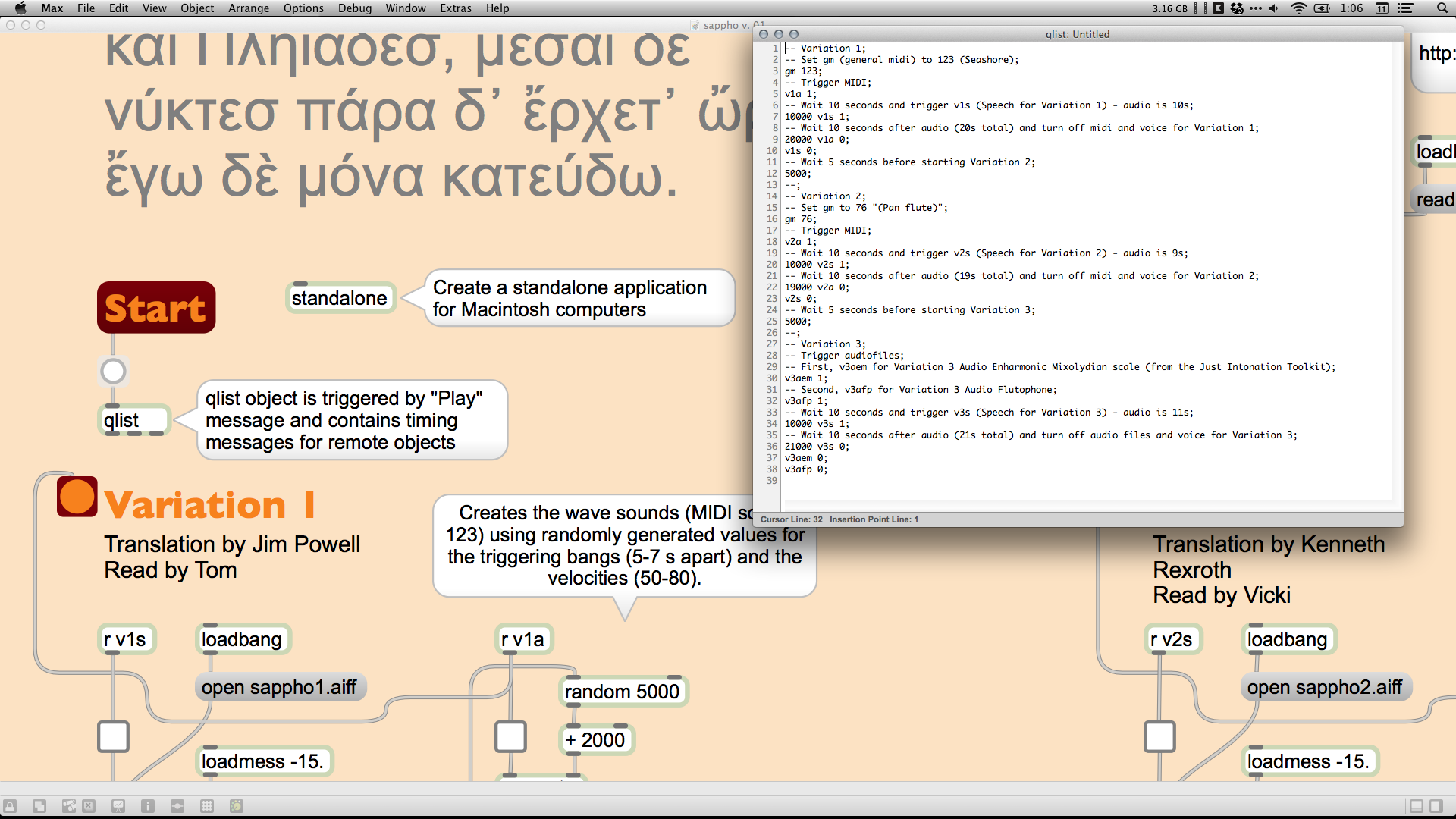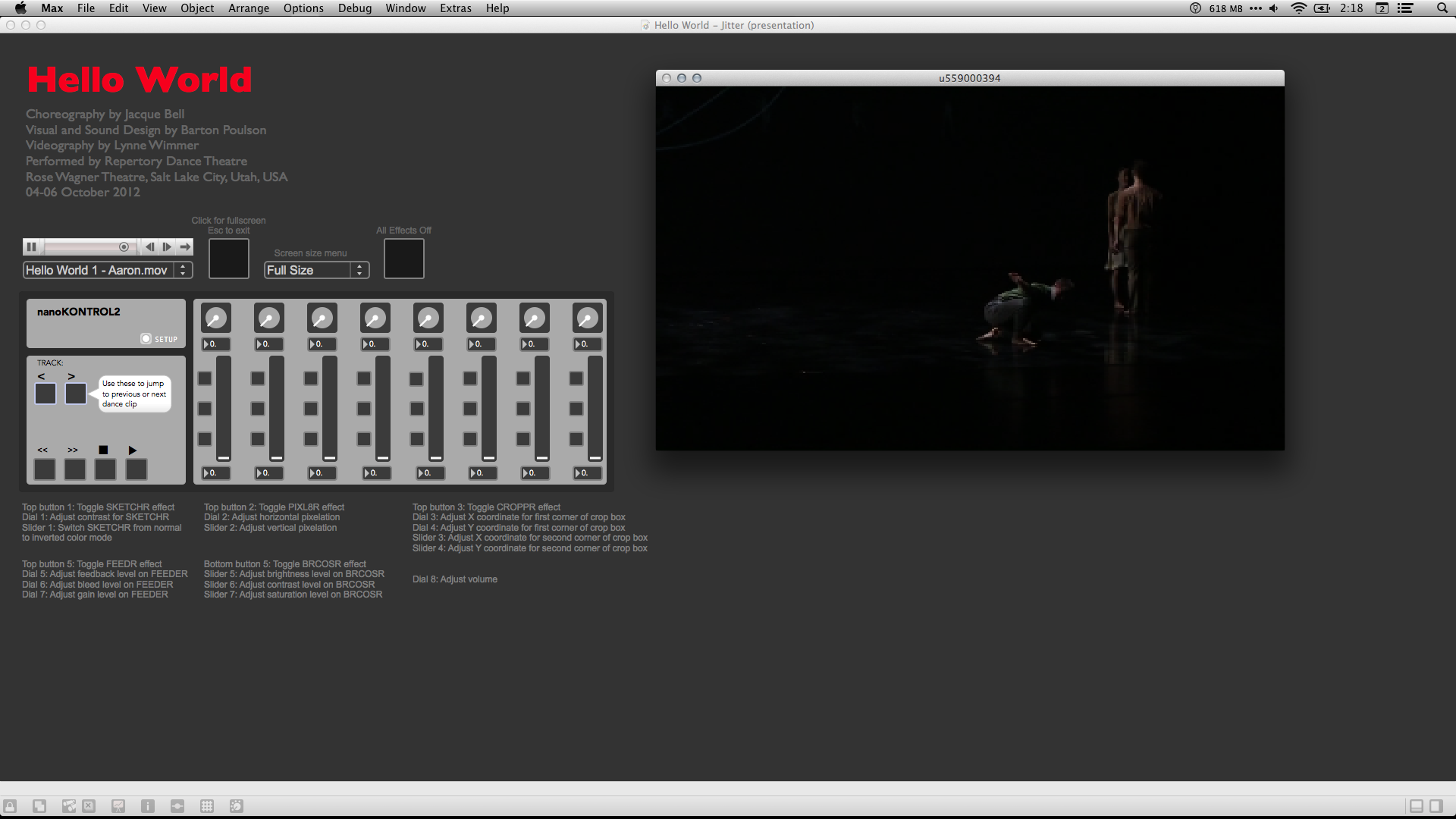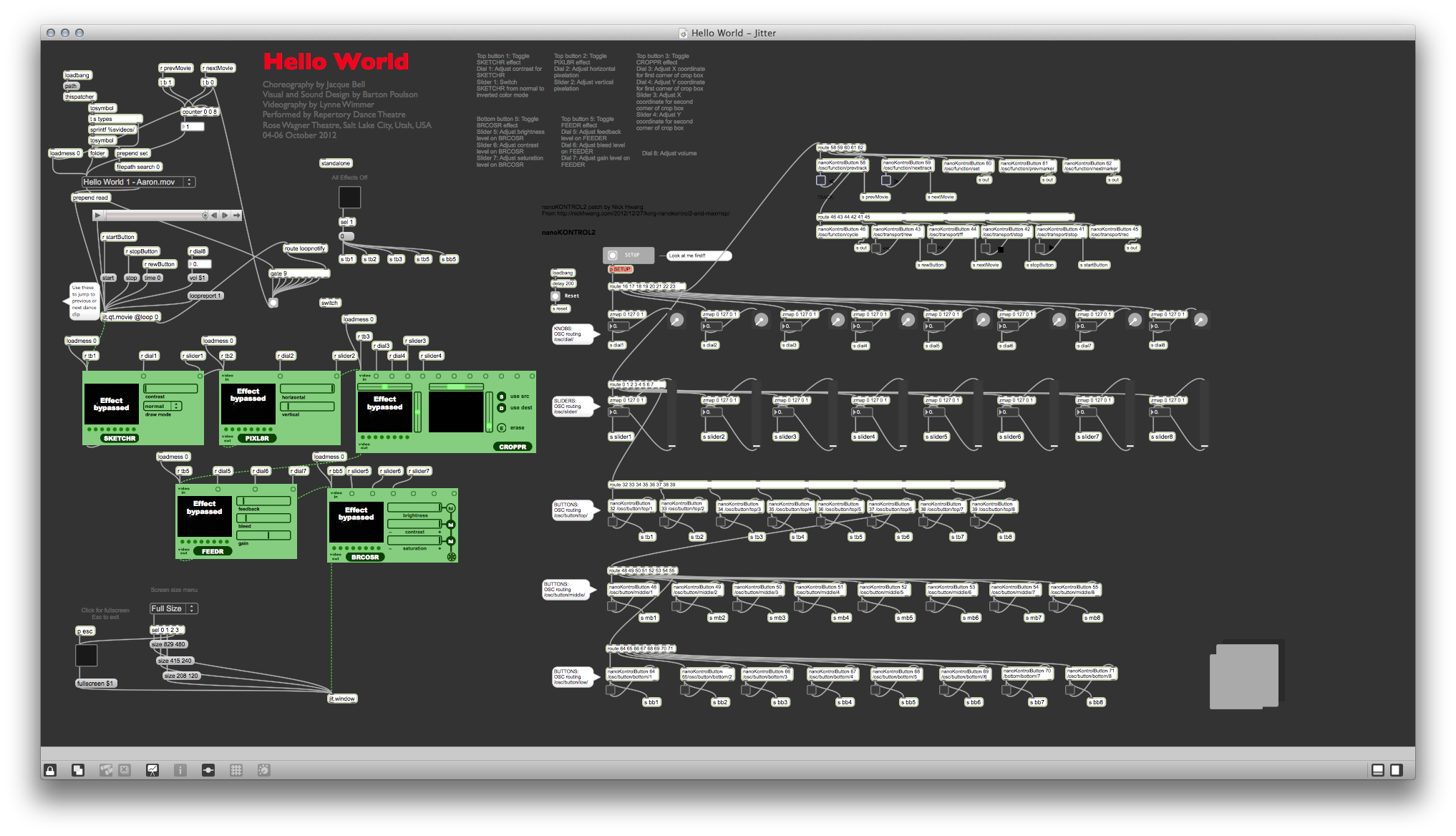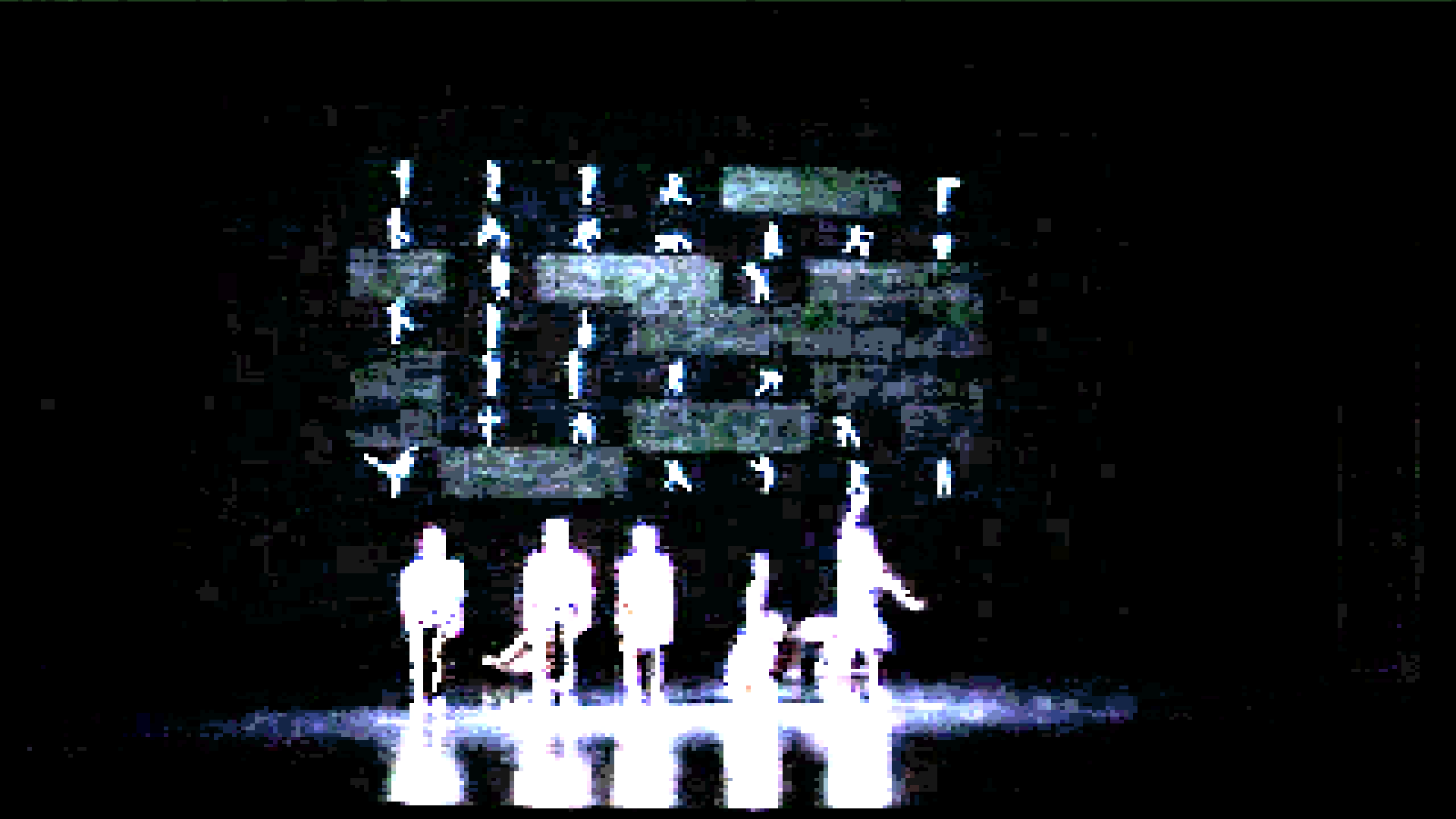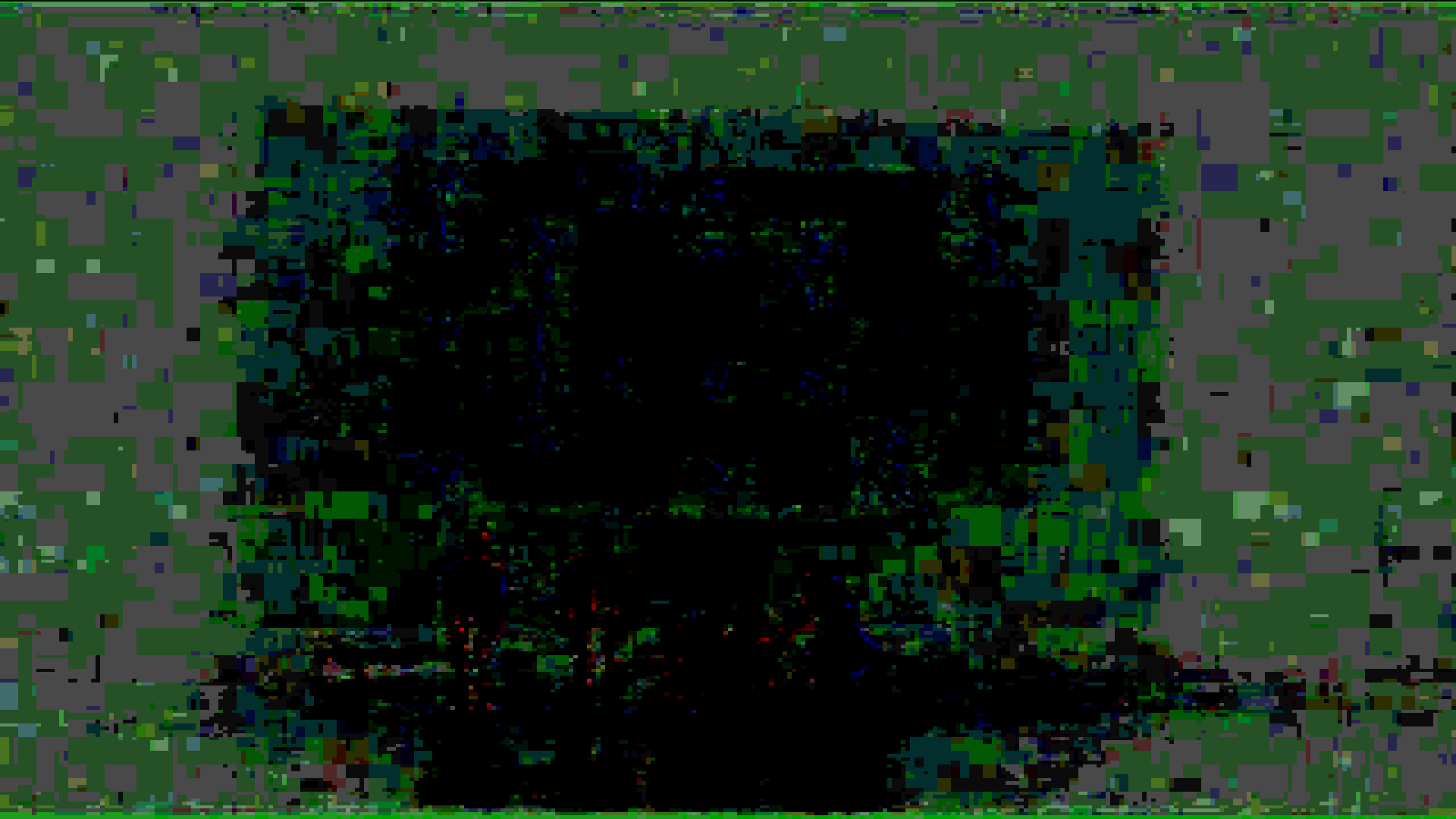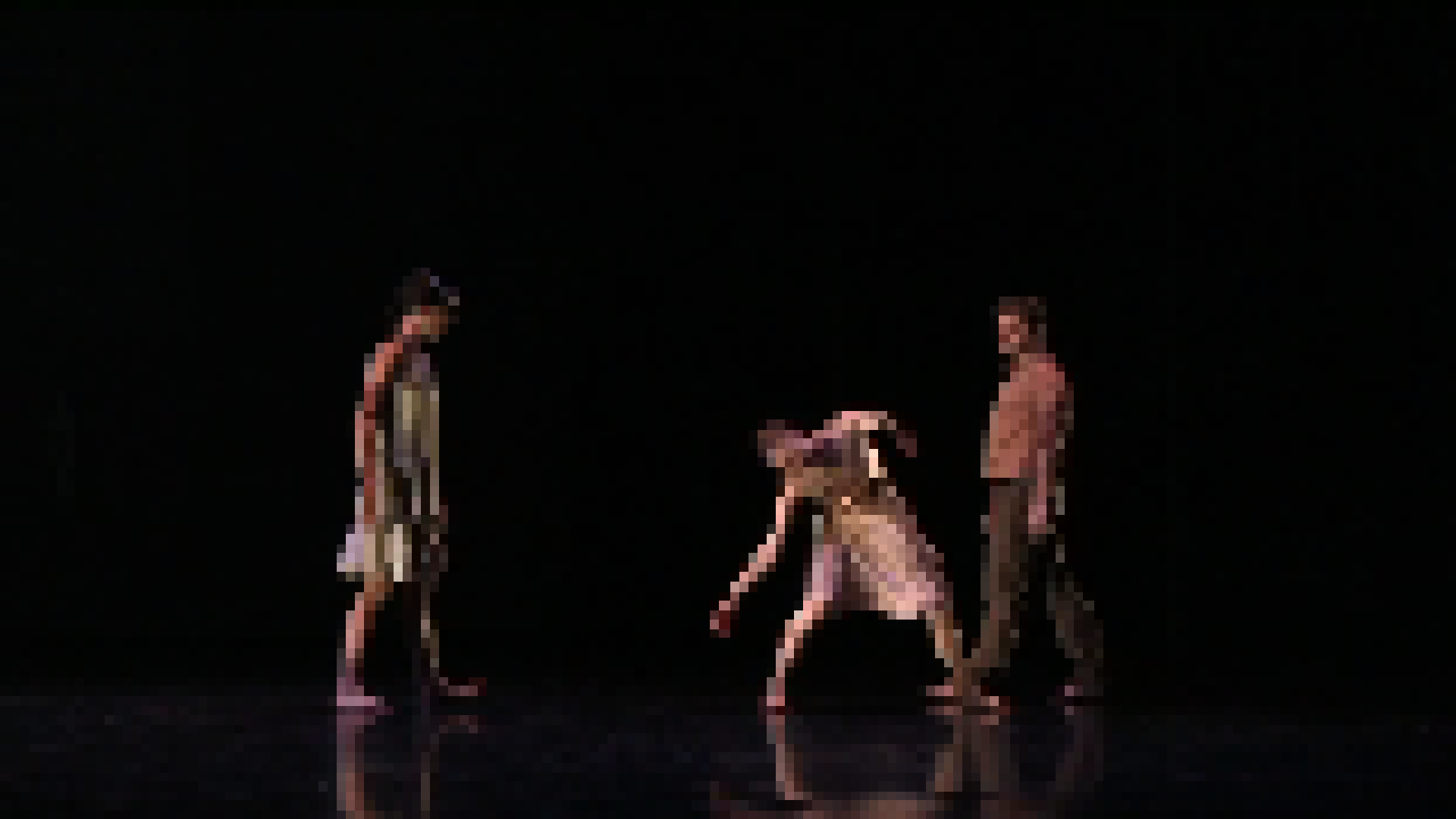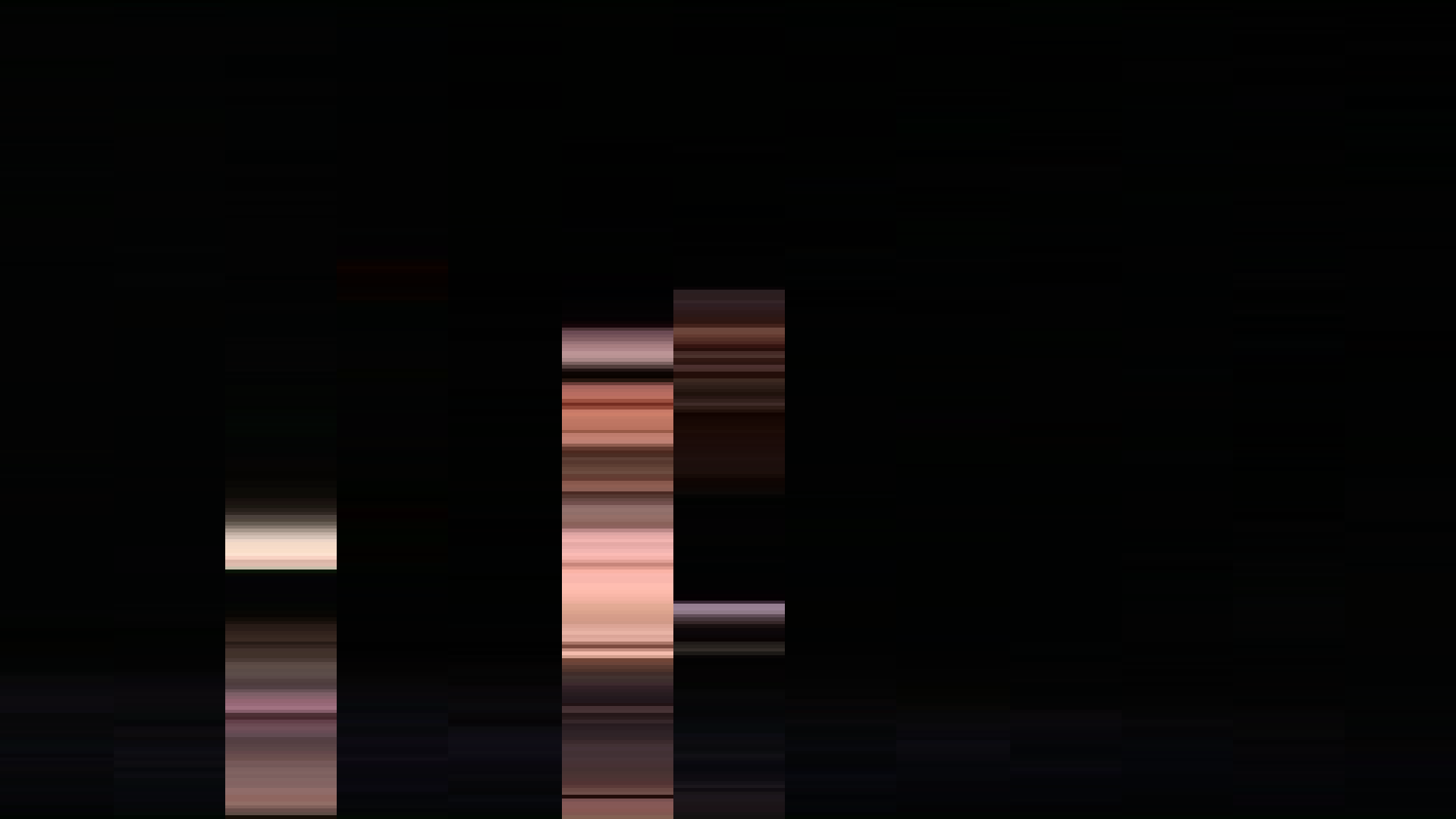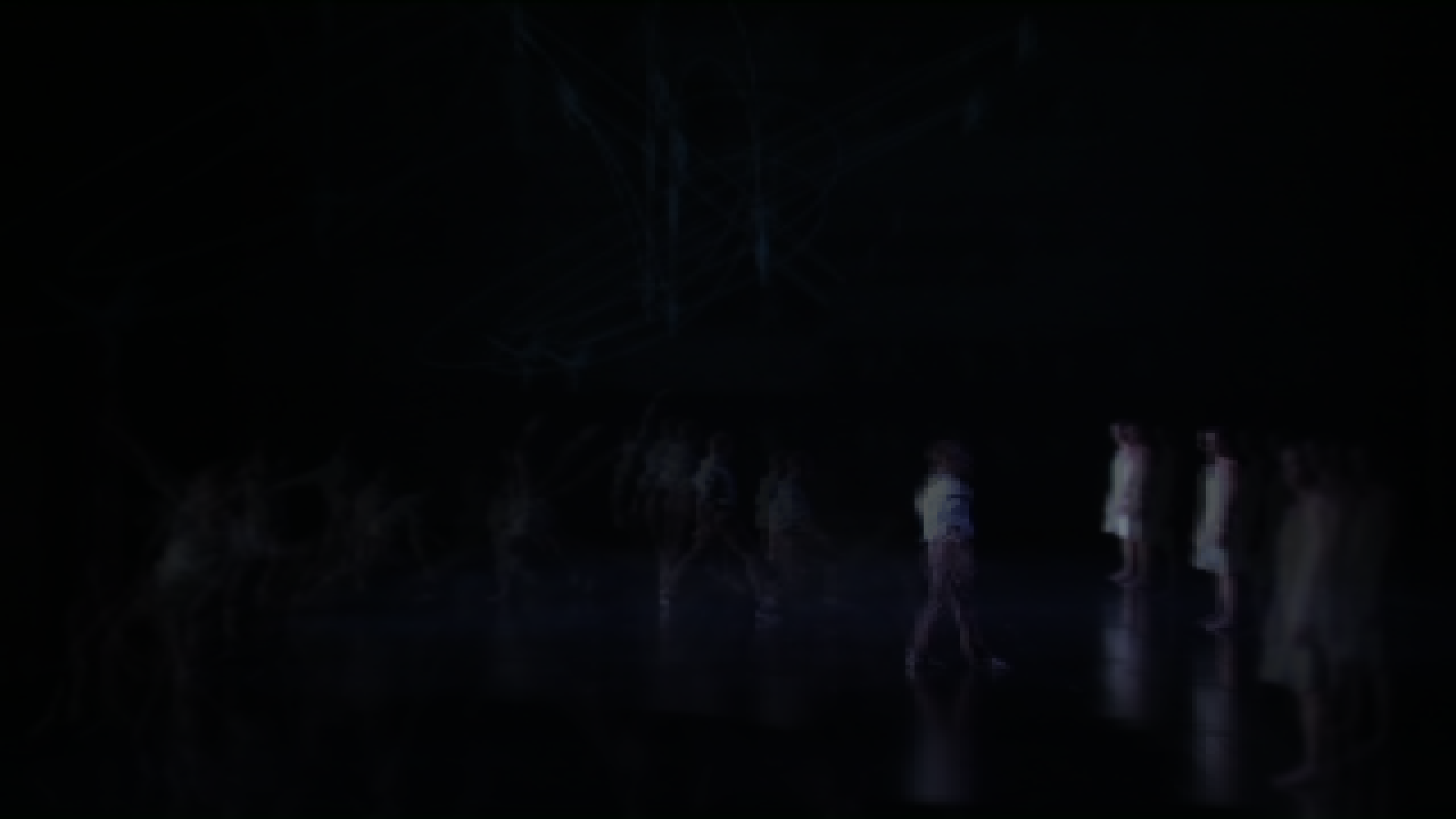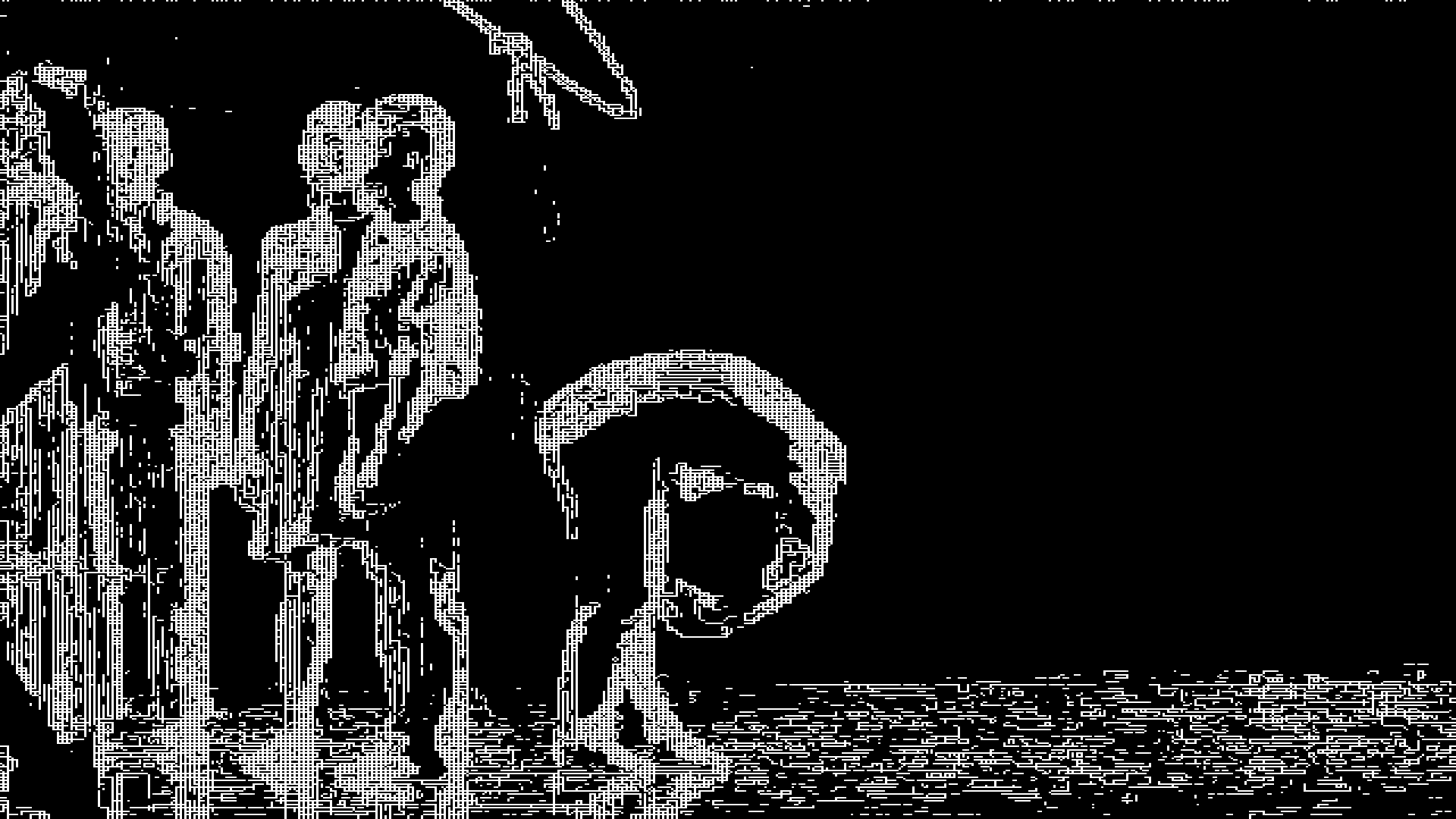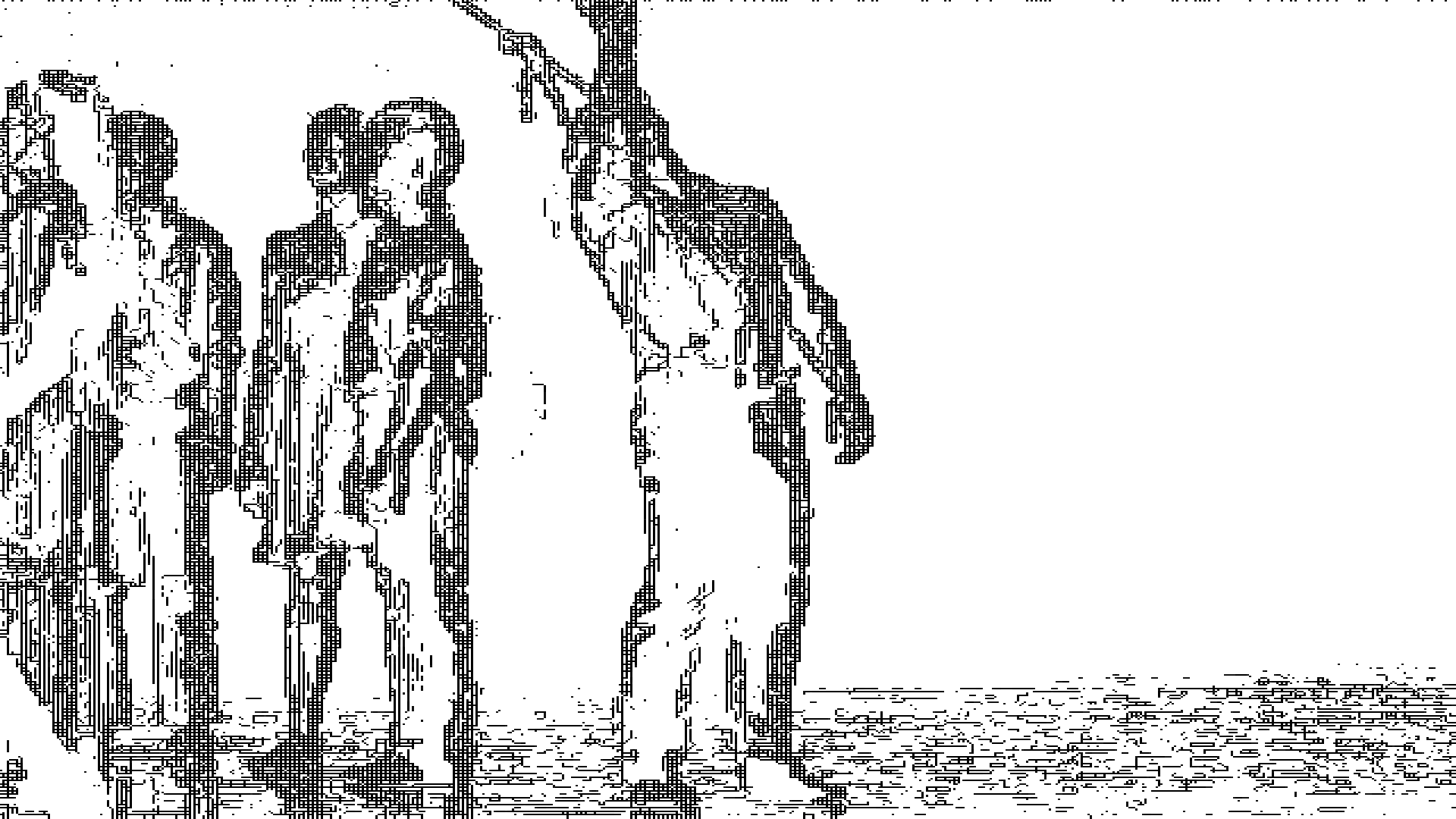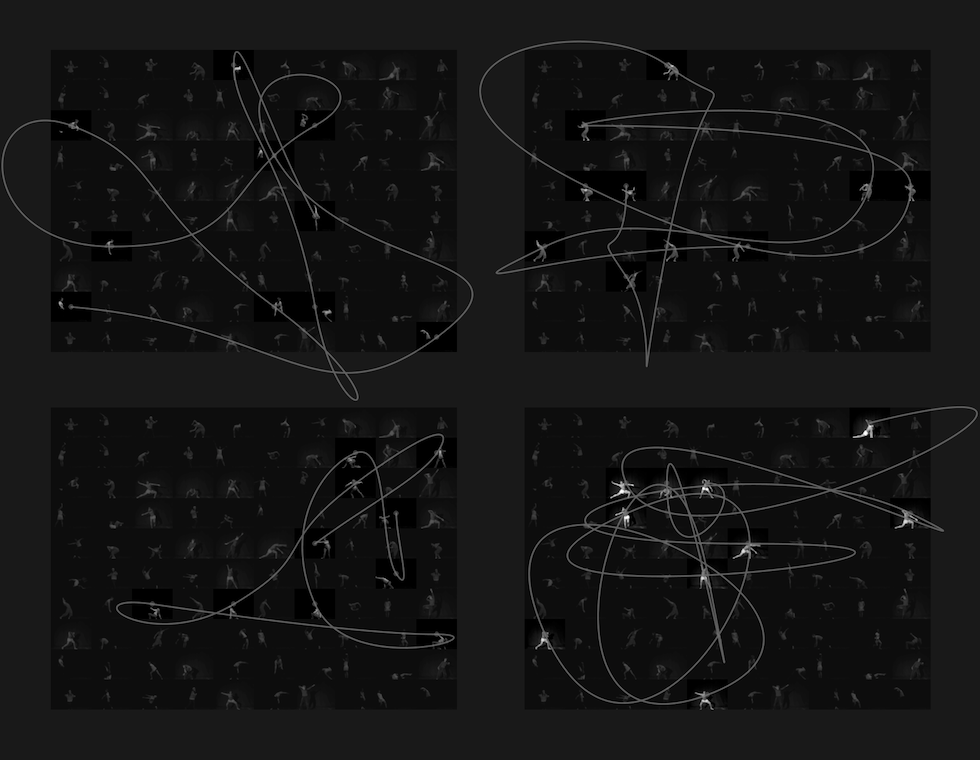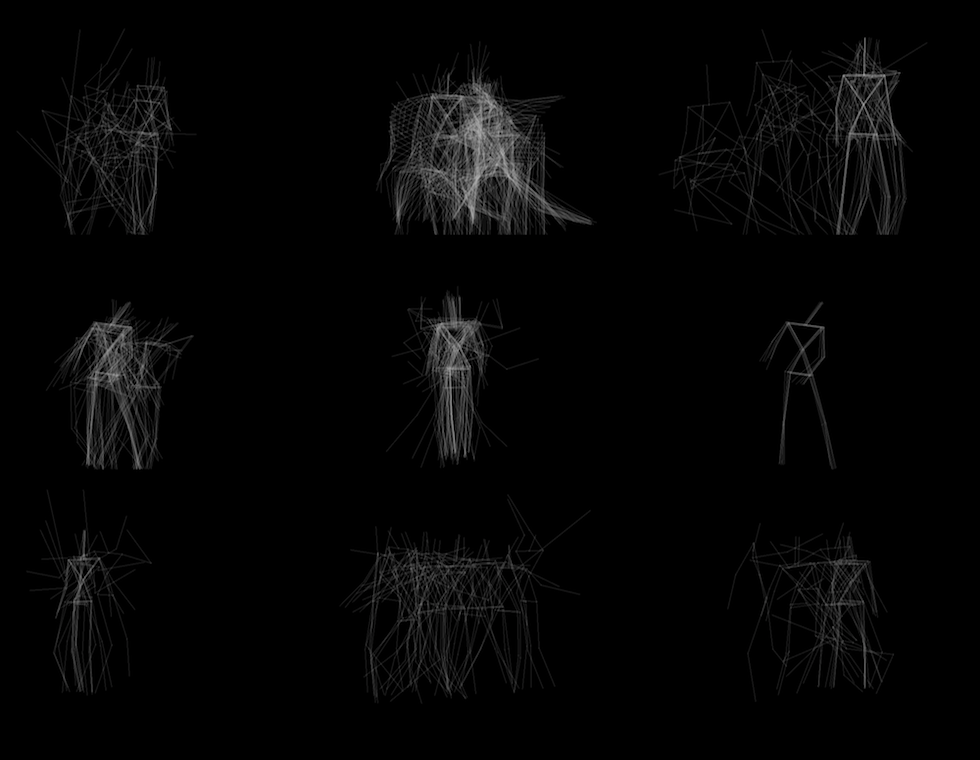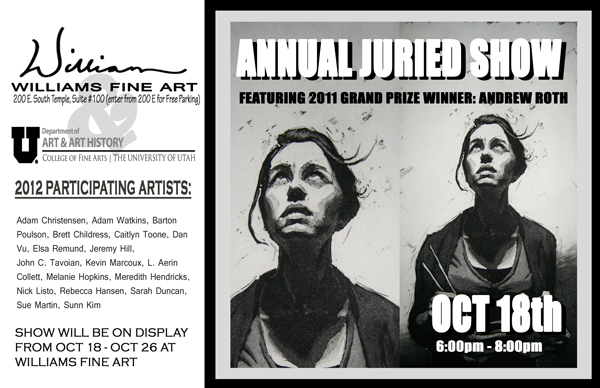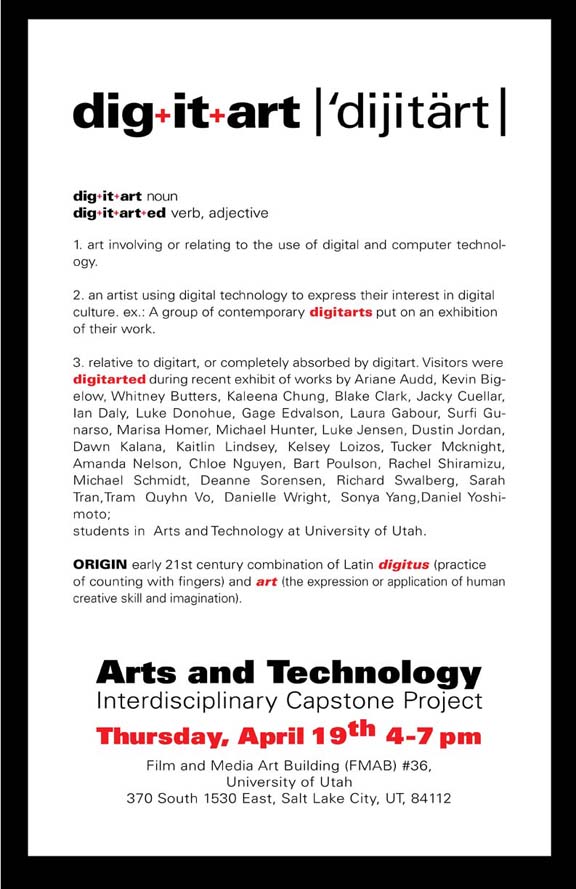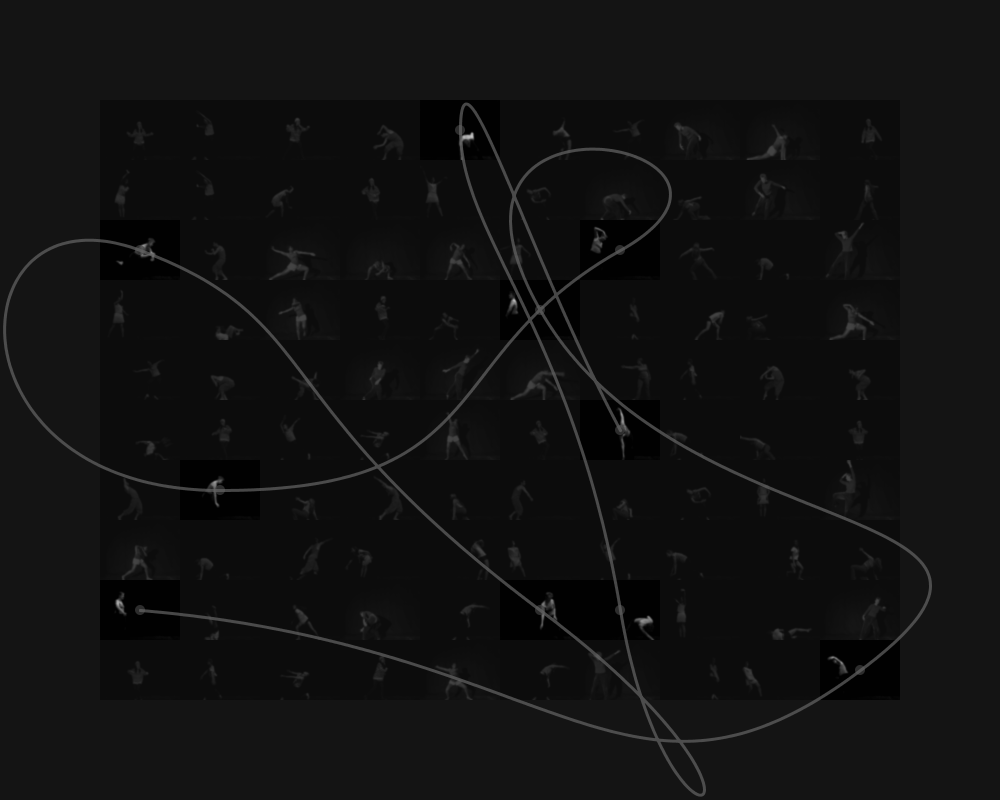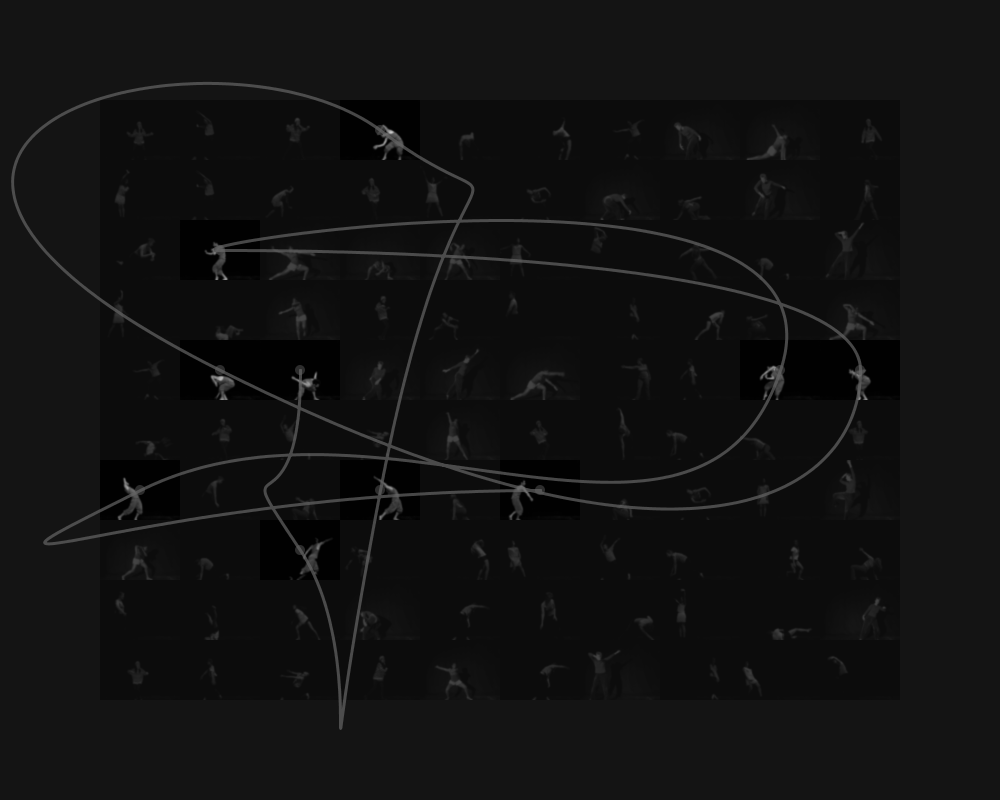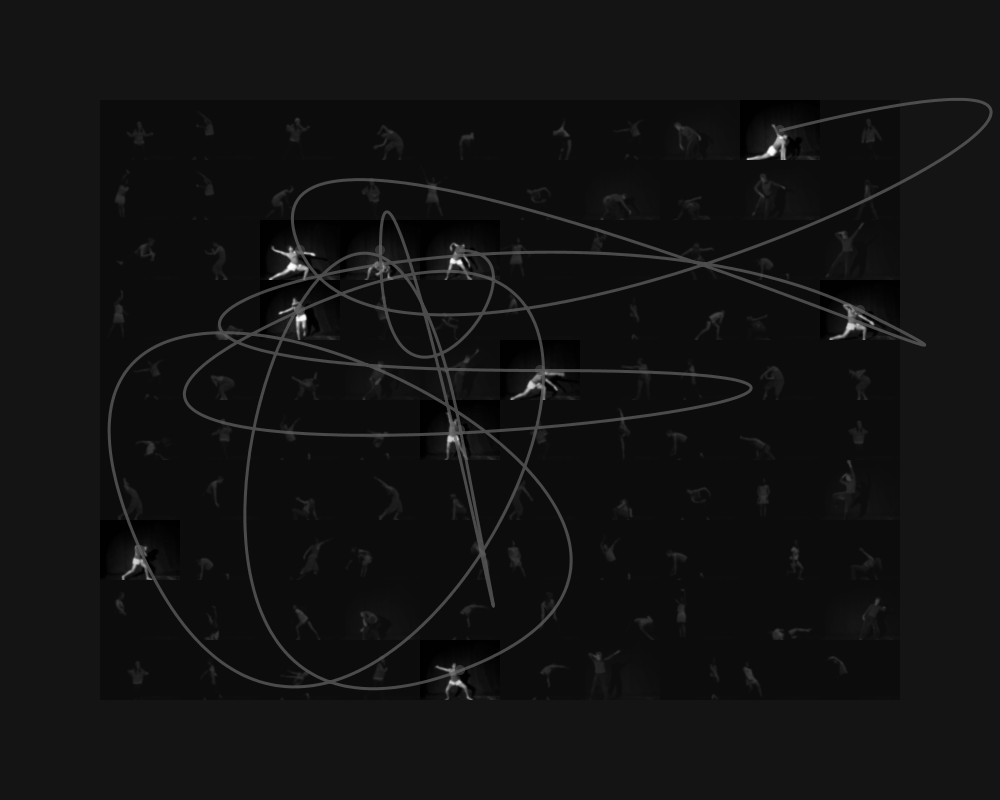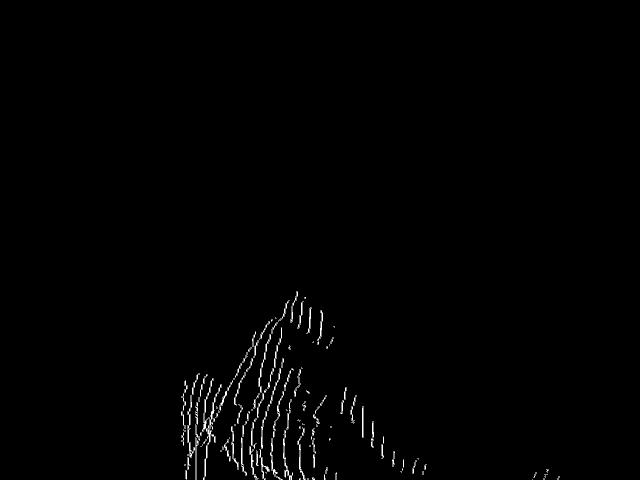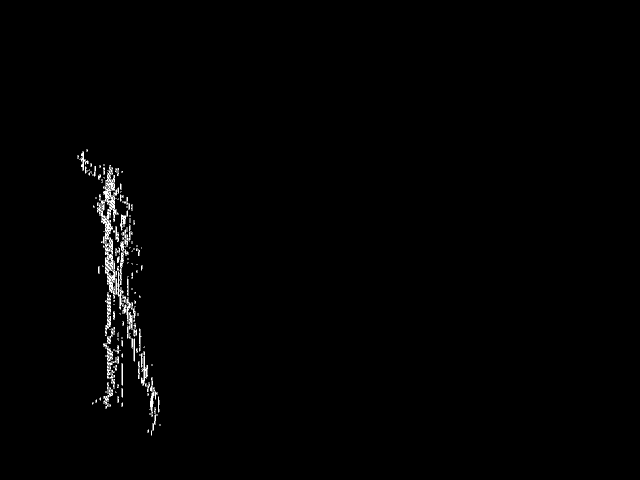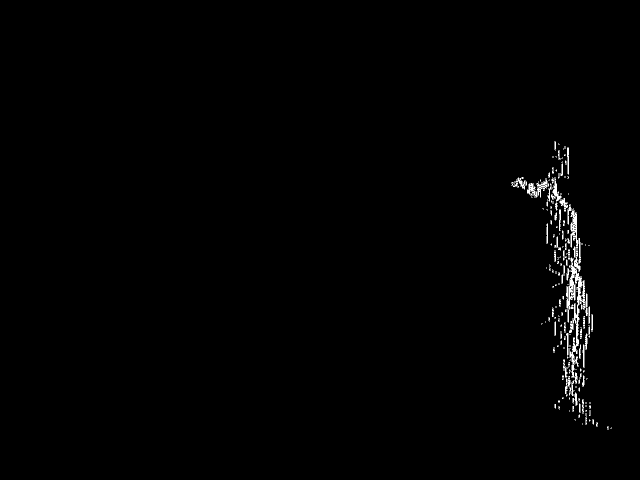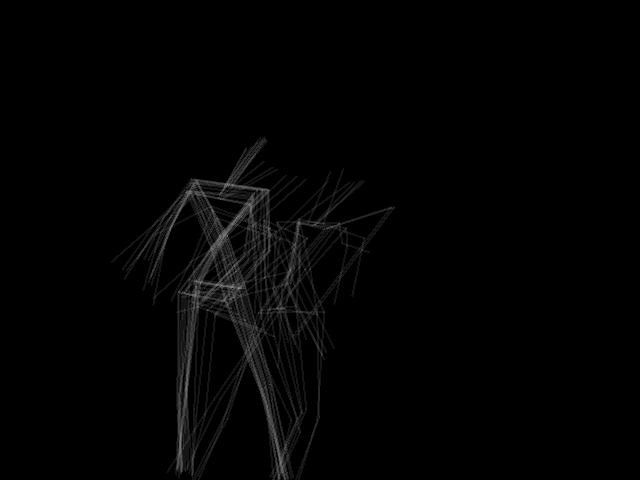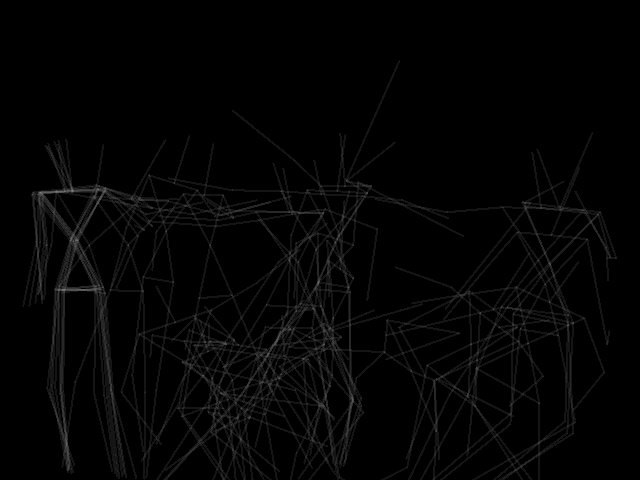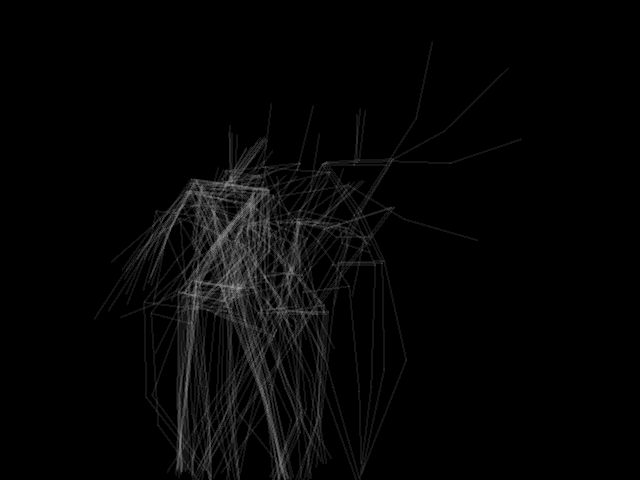Well, now. Google is sponsoring an event they call “DevArt” – as in “Developer Art” – that will lead to one artist being chosen to join a major exhibition at The Barbican in London. One of these days, one of these days....
Viewing entries tagged
art
[youtube=http://www.youtube.com/watch?v=hp2qb6KBQXY]
This second YouTube video provides a technical walkthrough of the project:
[youtube=http://www.youtube.com/watch?v=LtdOBfpWK30]
Here's the text version of that explanation (more or less). I wanted to have audio recordings of the three versions of the poem. Because I could and because I thought it would make a nice contrast with the extreme earthiness of the poem, I decided to use computer voices. I chose three of the voices that come with Macintoshes: Tom, Vicki, and Whisper. For each poem, I put the text in TextEdit and, in the TextEdit > Services menu, chose "Add to iTunes as a Spoken Track." (I think I added that function at some point but I can't remember when or from whence it came.) From there I converted each of the computer voice recordings from the default iTunes AAC format to a more-Max-friendly AIFF format and added them to the same folder as the Sappho patch.
In order to control the playback of the various items, I created a qlist object that would contain all the timing information and remote sends to the various objects. In each case, this started the background sounds first (for 5 seconds) and then the voice recordings (about 10 seconds), with the background continuing for about 10 more seconds after that.
Variation 1 uses Seashore sounds (MIDI 123) because, you know, Sappho lived on an island. These wave sounds are all the same length (3 seconds) but they start at randomized times (2-7 seconds apart) and play with randomized velocities/volumes (50-80 on a 0-127 scale). Those variations make the artificial MIDI waves sound a little more realistic.
Variation 2 uses a Greek instrument, Pan flutes (MIDI 76), to plays loops of a descending scale, as descending is more in line with the melancholy feel of the poem. The scale is D minor for two reasons: the minor scales are identical to the Greek Aeolian scales and, as we learned from Nigel Tufnel in This Is Spinal Tap, "D minor... is the saddest of all keys, I find. People weep instantly when they hear it, and I don't know why." The MIDI notes for the scale are contained in a coll object and are referenced in a looping manner by a counter object. Like the waves in Variation 1, the notes in the descending scale start at randomized times (1-3 seconds apart) but stay in order and have randomized velocities/volumes (20-50). In addition, a message of "1" that connects the toggle and the counter object makes sure that the scale always starts at the top note.
Variation 3 concludes the performance with music that I personally performed and recorded. There are two music elements playing simultaneously: (1) MIDI keyboard of a zither playing in an Enharmonic Mixolydian scale, and (2) an toy plastic flutophone. The most complicated part of this patch was the routing necessary to make it possible to randomly select and start one of the three recordings in each element while still allowing the qlist to serve as a master on/off control. This was accomplished with dual toggles and gates for each element.
As a note, the keyboard part of Variation 3 was possible using Tom Mudd's Just Intonation Toolkit, which is an application developed in Max/MSP that makes it possible to play several variations of justly tuned scales. (The video below is a short demonstration of this software.)
[youtube=http://www.youtube.com/watch?v=P_9c-MMGmI4]
I have a lot of possibilities for expanding this project in the future, hence the "v. 01" label. Stay tuned for more!
Downloads:
- Zipped folder with Max patch and supporting files [fixed 2015-03-17]
- Zipped standalone application for Mac [fixed 2015-03-17]
I did two major things for this Jitter project:
- Worked with several different visual effects within Jitter (as facilitated by the Vizzie modules); and
- Experimented with using a hardware controller – a Korg nanoKONTROL2, in this case – to manipulate video in real time.
Overall, it was a lot of fun and I think there's a lot of potential there. I'll spend the next several months learning ways to work out the kinks in the patch, as not everything worked reliably, and learning how to use other hardware, such as my Kinects, Novation Launchpads, Akai APC40 and 20, KMI Softstep and QuNeo, as well as the projectors, etc. (That's the nice thing about grant money – you can get some excellent gear!)
The major lesson is that it is much, much, much easier to do a lot of this in Max/MSP/Jitter than it is in Processing, which is what I have been using for the last two or three years. The programming is easier, the performance seems to be much smoother, and the hardware integration is way, way easier. (I find it curious, though, that there are hardly any books written about Max/MSP/Jitter, while there are at least a dozen fabulous books about Processing. Go figure.)
I've included a few still shots at the top of this post and a rather lengthy walk-through of the patch (where not much seems to be working right at the moment...) below.
[youtube=http://youtu.be/NR_mlAQUipM]
As one more surprising development in my artistic life, I created some still pieces based on the dance visualization project that I did at the U of U (see this entry) and submitted them to the annual juried show for U of U art students at Williams Fine Art, a long-standing art gallery in Salt Lake City. Shockingly, I got accepted! (See, I'm the third person on the list.)
In the process, I gave a little theoretical background on the pieces I created. Here's what I put in my rather lengthy artist statement:
Dance is a challenging medium. It is notoriously ephemeral, as it disappears once the performance is finished. It is temporal, as it is always viewed in a particular order: first the beginning, then the middle, and then the end. And dance is situated, as the viewer typically has a single visual perspective throughout the entire performance.
In a series of experiments called “Danco kaj la universala okulo,” which is Esperanto for “Dance for the universal eye,” alternative to each of these characteristics were explored. To do so, ten dance performances were recorded with a Microsoft Kinect to get digital video and 3D motion capture data, which were then manipulated in Processing.
The first manipulation, “Danco 1: Preter spaco” (“Dance 1: Beyond Space”), presented point clouds – 3D pixel images – of the dancers. Viewers could change their perspective of the dance at will, even during the live performance: zooming in and out, rotating left and right, or going above or below the dancers.
The second manipulation, “Danco 2: Preter ordo” (“Dance 2: Beyond Order”), which is the basis of this print, was an interactive application that placed frames from all ten dances in random order. However, viewers could click on a frame and all of the frames from that dance would be highlighted and connected in order by a curving line. (The line is a Catmull-Rom spline with a random tension factor.) Viewers could then click a button and the selected frames would reassemble themselves in temporal order. As a note, this piece provided the seed for a recent multimedia and dance performance for Repertory Dance Theatre called “Hello World,” which was created with choreographer Jacque Bell.
The final manipulation, “Danco 3: Preter tempo” (“Dance 3: Beyond Time”), derived skeleton views from the pixel data and then accumulating figures as the dance progressed. In this way, the entire dance was simultaneously present as a unitary whole.
The prizes at the show went to actual artists, which is not surprising (although UVU did give me their own whopper prize a few months ago with the fellowship for Dance Loops). The show, however, was a fabulous experience and – hopefully – the first first of many to follow.
[And, yes, I do/did own a beret. However, I don't have any idea where it is. And I don't have any black turtlenecks, so I guess I have to pass on the artist image.
 Woo hoo! The National Endowment for the Arts (NEA) has made it official: Video games are art. Or, perhaps more accurately, video games are a legitimate medium for legitimate art. Just all oil paintings can be art (but certainly not all oil paintings...), so can video games. Here's a link to a great post on four game projects that were funded in 2012 as part of the NEA's Arts in Media grants.
Woo hoo! The National Endowment for the Arts (NEA) has made it official: Video games are art. Or, perhaps more accurately, video games are a legitimate medium for legitimate art. Just all oil paintings can be art (but certainly not all oil paintings...), so can video games. Here's a link to a great post on four game projects that were funded in 2012 as part of the NEA's Arts in Media grants.
Now, I should mention that I never really spent that much time playing video games as a kid or as an adult. For that matter, I don't really read much fiction, either. (I prefer poetry and nonfiction.) But I'm thrilled by this development nonetheless.
Tonight was "dig+it+art," otherwise known as the Capstone Showing for the Arts Technology Certificate Program at the University of Utah. As I have been participating in this program all year for my sabbatical, I got to show a piece as well. My piece was entitled "Dots and Lines and Dance and All of Us."
To create it, I recruited a group of dancers (mostly freshman modern dance students at the University of Utah but also my wife, Jacque, who is a professional modern dance choreographer) and had each of them improvise a 10-second sequence that I filmed with a Kinect hooked up to my MacBook and running through Processing. From there, I took the RGB video at 1 FPS and ran it through a nice, blurry B&W filter, placed the 100 resulting images on a grid in random order, and made it possible to connect the images from a dance with a Catmull-Rom spline. (Of course....) I also created videos of the point clouds and skeletons, also at 1 FPS. Each of the three parts – clouds, grid, and skeletons – was projected on a large wall. Lots of fun!
[This is a cross-post from my data blog, Data-Literacy.com. Here's the link to the original entry there.]
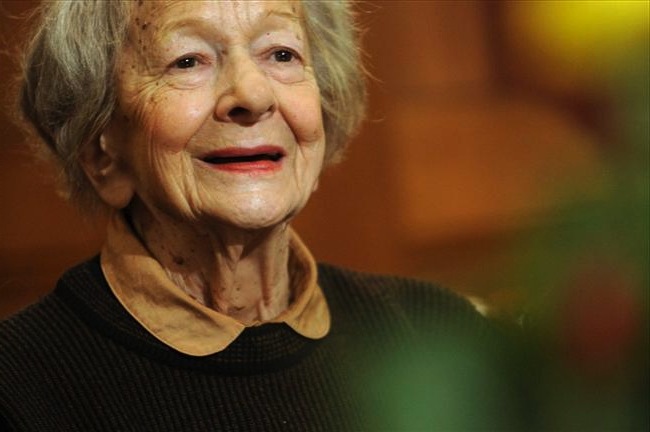
Poet and Nobel Laureate Wisława Szymborska — that's her, right above — died last week at 88 years old. I have included this poem in my data analysis classes for a few years because: (a) I love poetry; (b) it has statistics; and (c) as a social psychologist, I believe it summarizes human nature wonderfully.
••
Out of a hundred people…
those who always know better:
fifty-two
doubting every step:
nearly all the rest
glad to lend a hand
if it doesn’t take too long:
as high as forty-nine
always good
because they can't be otherwise:
four, well maybe five
able to admire without envy:
eighteen
suffering illusions
induced by fleeting youth:
sixty, give or take a few
not to be taken lightly:
forty and four
living in constant fear
of someone or something:
seventy-seven
capable of happiness:
twenty-something tops
harmless singly, savage in crowds:
half at least
cruel
when forced by circumstances:
better not to know
even ballpark figures
wise after the fact:
just a couple more
than wise before it
taking only things from life:
thirty
(I wish I were wrong)
hunched in pain
no flashlight in the dark:
eighty-three
sooner or later
righteous:
thirty-five, which is a lot
righteous
and understanding:
three
worthy of compassion:
ninety-nine
mortal:
a hundred out of a hundred.
thus far this figure still remains unchanged.
Related articles
- Wisława Szymborska, 1923-2012 (sophiemalik.wordpress.com)
- Wislawa Szymborska - "The Mozart of poetry" - is dead at 88 (bookofjoe.com)
- "Life lasts but a few scratches of the claw in the sand." ~ Wislawa Szymborska, poet (poietes.wordpress.com)
- Wislawa Szymborska's Parable (cubiyanqui.com)
[Above: Stills from two critical video games by Molleindustria: "Oiligarchy" and "The McDonald's game."]
Woo hoo! The Sundance Film Festival is getting frisky! They've included non-film art — new media video work and video game art, to be particular — in this year's festival and, Holy Moses, there's some amazing things going on. The exhibit, entitled New Frontier, is on display at the Utah Museum of Contemporary Art through May 19.
Excellent large scale data visualizations about wildlife encroachment, a participatory Kinect piece about a disaster at a Los Angeles food bank, a 3-D celebration (sort of) of aggression in Hollywood, people raging at their computers, and video games that you always lose no matter what. It's all from what you might call "the art of discomfort" but it's amazing.
I'm so glad to see this in Salt Lake City!
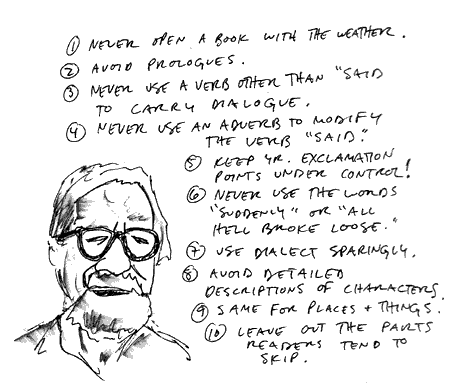 Writer Elmore Leonard was interviewed on NPR today. He was introduced with this pearl:
Writer Elmore Leonard was interviewed on NPR today. He was introduced with this pearl:
"I try to leave out the parts the readers skip."
Amen.
Related articles
- Elmore Leonard's 10 Rules For Great Writing (world-copywriting-institute.typepad.com)
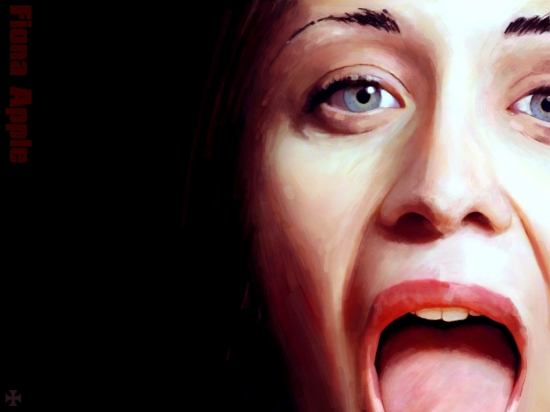 "The way I feel about music is that there is no right and wrong. Only true and false."
"The way I feel about music is that there is no right and wrong. Only true and false."
— Fiona Apple (as quoted in Daniel Shiffman's book Learning Processing)
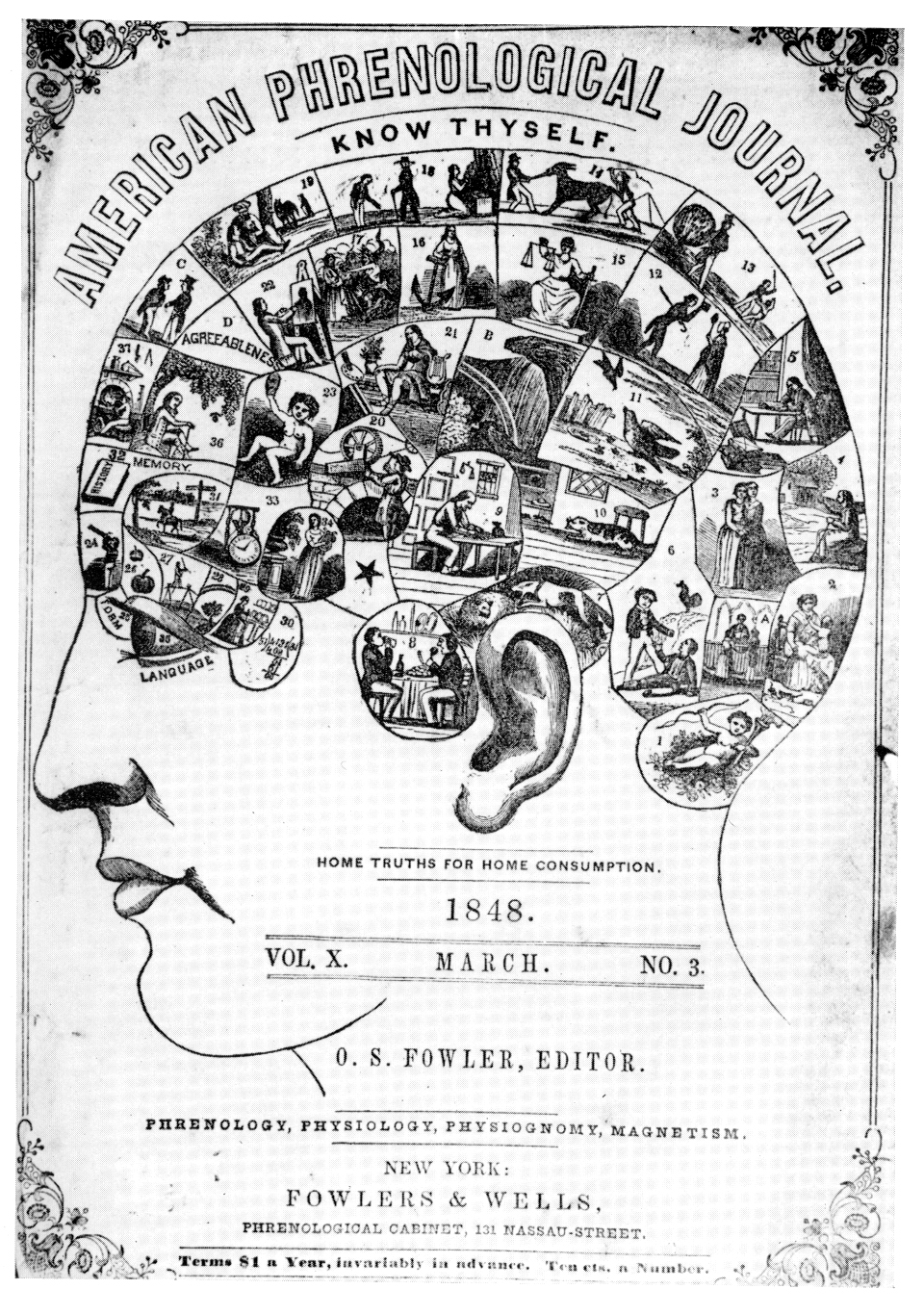 I gave a talk yesterday to the Cognition and Neural Science PhD students in the Psychology Department at the University of Utah. My title was “Art and the Psychological Scientist” (PDF available here). I talked about data art, information visualization, and Processing, among other things. It was very nice to finally connect with the Psych department there. (I am, after all, a psychology professor.) A few of the students are developing a course on art and psychology and I’m excited to see what comes of that. (And, Martin, that’s why I left class after the quiz; I had to get ready!)
I gave a talk yesterday to the Cognition and Neural Science PhD students in the Psychology Department at the University of Utah. My title was “Art and the Psychological Scientist” (PDF available here). I talked about data art, information visualization, and Processing, among other things. It was very nice to finally connect with the Psych department there. (I am, after all, a psychology professor.) A few of the students are developing a course on art and psychology and I’m excited to see what comes of that. (And, Martin, that’s why I left class after the quiz; I had to get ready!)
 To close out my music-listening-reporting for 2010, it's been more opera. And while the picture above is posted in jest, I actually love Wagner. And note the three non-opera albums at the bottom. Great stuff all around.
To close out my music-listening-reporting for 2010, it's been more opera. And while the picture above is posted in jest, I actually love Wagner. And note the three non-opera albums at the bottom. Great stuff all around.
Opera:
- Isaac Albéniz
- Marie Nelson Bennett
- Gaetano Donizetti
- John Eaton
- Carl Orff
- Thomas Pasatieri
- Sergei Prokofiev
- Gioachino Rossini
- Giuseppe Verdi
- Jaromír Weinberger
- Scott Wheeler
Choral:
- Anonymous 4
- Johann Sebastian Bach
- Marc-Antoine Charpentier
Vocalists:
- Barbara Bonney
- Carlo Bergonzi
- Cecilia Bartoli
- Christa Ludwig
- Diana Damrau
- Fritz Wunderlich
- Joan Sutherland
- Jon Vickers
- José Carreras
- Jussi Björling
- Kathleen Battle
- Kiri Te Kanawa
- Leontyne Price
- Magdalena Kožená
- Michael Chance
- René Pape
- Titta Ruffo
- Will Perkins (my brilliant nephew, current working on a doctorate at Indiana University!)
Others:
- Carl Philipp Emanuel Bach's piano sonatas
- James Carter "Present Tense" (amazing saxophonist)
- Digital version of "Stay Awake: Various Interpretations of Music from Vintage Disney Films"




